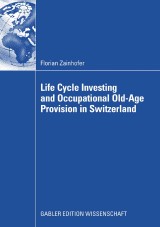Details

Life Cycle Investing and Occupational Old-Age Provision in Switzerland
|
53,49 € |
|
| Verlag: | Gabler |
| Format: | |
| Veröffentl.: | 01.08.2008 |
| ISBN/EAN: | 9783834998187 |
| Sprache: | englisch |
| Anzahl Seiten: | 279 |
Dieses eBook enthält ein Wasserzeichen.
Beschreibungen
Institutional framework, motivation and objectives.- Methodology: state-of-the-art.- Methodology: computational aspects.- Empirical analysis of Swiss labor income dynamics.- Illustration of life cycle portfolio choice for stylized Swiss investors.- Welfare analysis.- Conclusions.
Dr. Florian Zainhofer promovierte bei Prof. Dr. Martin Wallmeier am Lehrstuhl für Finanzmanagement der Université de Fribourg, Schweiz.
Swiss economists have proposed to individualize the funded second pillar of the Swiss retirement provision system (BVG) by granting employees flexibility with respect to the contribution rate and risky asset share in their accounts. Opponents have stressed that such a reform would transfer the investment risk from pension funds to financially illiterate employees and thus imply a welfare loss. <br>
<br>
Florian Zainhofer uses the theory of life cycle investing, i.e. how we should optimally choose our savings rate and risky asset share throughout our lives, as a framework to study the implications of a potential BVG individualization. Following an introduction on the Swiss system of old-age provision, the author reviews recent life cycle models of portfolio choice and covers their numerical solution algorithms in depth. He presents an empirical analysis of Swiss workers’ earnings dynamics since these are important determinants of life cycle investment behavior. To further investigate the implications of a flexible contribution rate and risky asset share in the mandatory BVG, the author proposes a model adapted to Swiss conditions and parameterized with the estimated earnings dynamics.<br>
<br>
Florian Zainhofer uses the theory of life cycle investing, i.e. how we should optimally choose our savings rate and risky asset share throughout our lives, as a framework to study the implications of a potential BVG individualization. Following an introduction on the Swiss system of old-age provision, the author reviews recent life cycle models of portfolio choice and covers their numerical solution algorithms in depth. He presents an empirical analysis of Swiss workers’ earnings dynamics since these are important determinants of life cycle investment behavior. To further investigate the implications of a flexible contribution rate and risky asset share in the mandatory BVG, the author proposes a model adapted to Swiss conditions and parameterized with the estimated earnings dynamics.<br>
Swiss economists have proposed to individualize the funded second pillar of the Swiss retirement provision system (BVG) by granting employees flexibility with respect to the contribution rate and risky asset share in their accounts. Opponents have stressed that such a reform would transfer the investment risk from pension funds to financially illiterate employees and thus imply a welfare loss. <br>
<br>
Florian Zainhofer uses the theory of life cycle investing, i.e. how we should optimally choose our savings rate and risky asset share throughout our lives, as a framework to study the implications of a potential BVG individualization. Following an introduction on the Swiss system of old-age provision, the author reviews recent life cycle models of portfolio choice and covers their numerical solution algorithms in depth. He presents an empirical analysis of Swiss workers’ earnings dynamics since these are important determinants of life cycle investment behavior. To further investigate the implications of a flexible contribution rate and risky asset share in the mandatory BVG, the author proposes a model adapted to Swiss conditions and parameterized with the estimated earnings dynamics.<br>
<br>
Florian Zainhofer uses the theory of life cycle investing, i.e. how we should optimally choose our savings rate and risky asset share throughout our lives, as a framework to study the implications of a potential BVG individualization. Following an introduction on the Swiss system of old-age provision, the author reviews recent life cycle models of portfolio choice and covers their numerical solution algorithms in depth. He presents an empirical analysis of Swiss workers’ earnings dynamics since these are important determinants of life cycle investment behavior. To further investigate the implications of a flexible contribution rate and risky asset share in the mandatory BVG, the author proposes a model adapted to Swiss conditions and parameterized with the estimated earnings dynamics.<br>


















